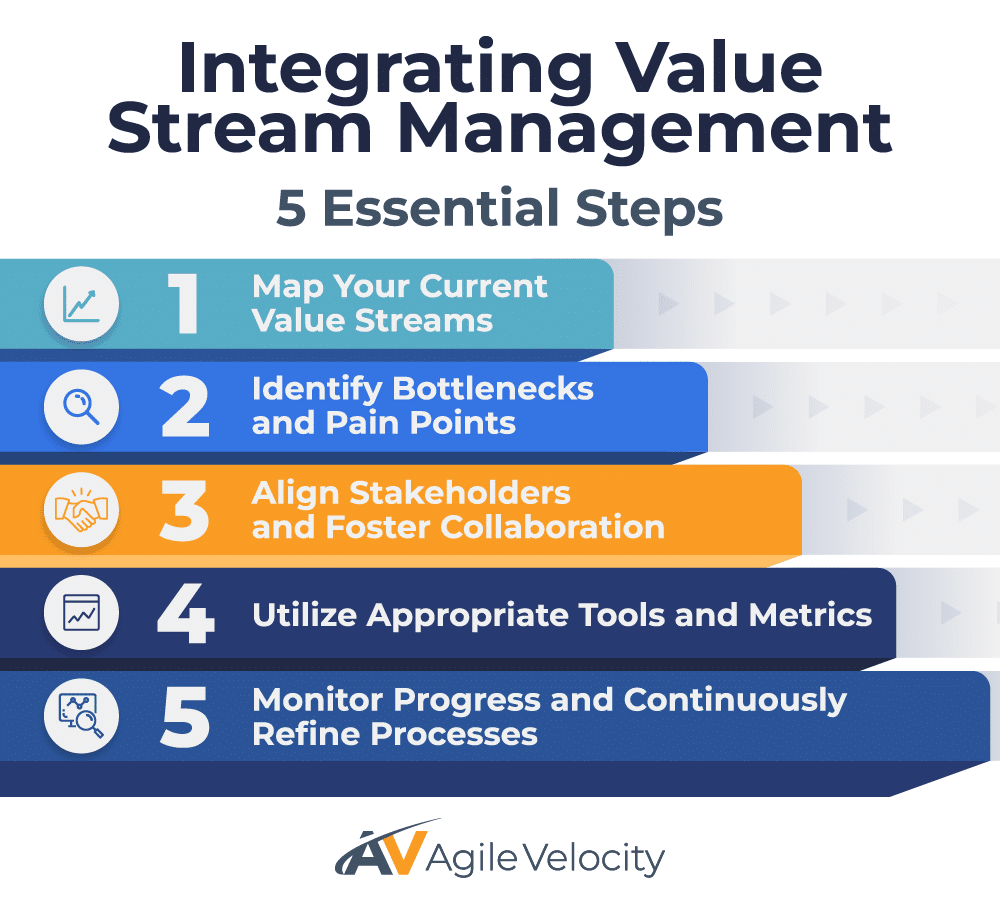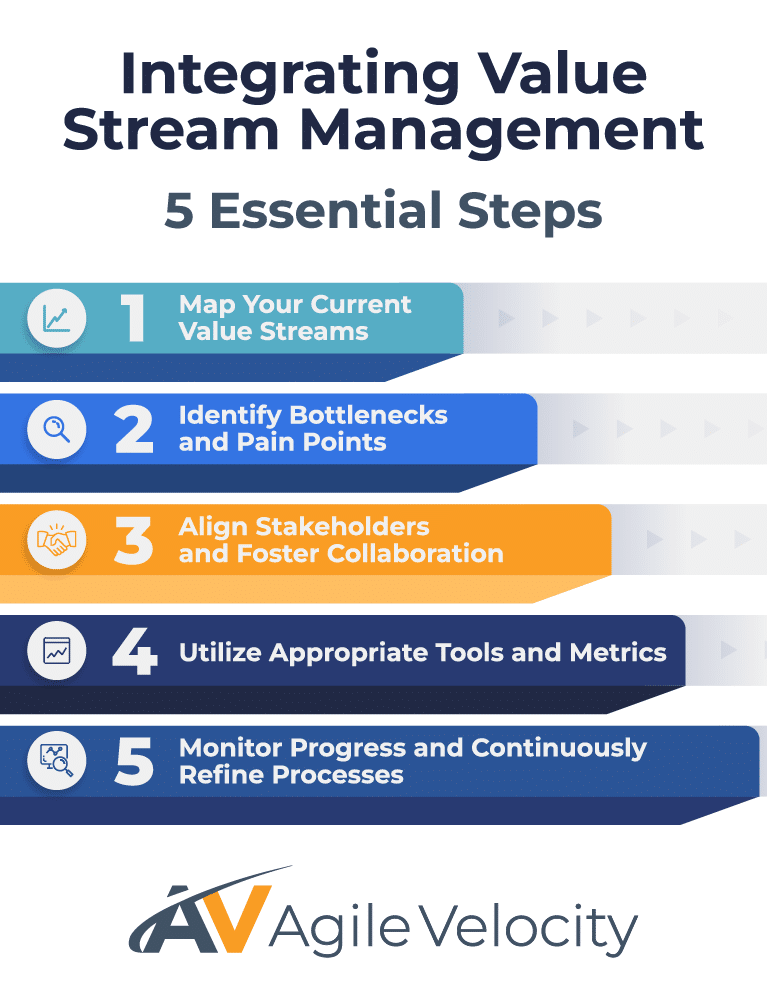In today’s competitive environment, organizations must connect strategic objectives with daily execution to deliver value efficiently. Value Stream Management achieves this by providing visibility, alignment, and continuous improvement across the entire value delivery process. For Agile enterprises, this results in faster, more reliable delivery of customer-centric outcomes.
This article explores how Value Stream Management drives organizational agility and actionable improvements, highlights its benefits, and offers practical steps for implementation. We also explain how the Path to Agility approach—coupled with Path to Agility® Navigator software tool—serves as an effective tool to bridge the gap between strategy and execution.
What is Value Stream Management in Agile Enterprises?
Value Stream Management is the practice of mapping and optimizing all activities that turn a concept into a delivered product. Rather than focusing exclusively on team-level execution with frameworks like Scrum and Kanban, it provides a holistic view of how every part of an organization contributes to customer value. This comprehensive approach helps identify inefficiencies, reduce waste, and ensure that all processes align with overarching business objectives.
The modern business landscape demands efficiency and a relentless focus on value delivery. With rapid technological changes and increased customer expectations, organizations can no longer rely solely on isolated team efforts. Instead, a unified, end-to-end strategy is essential for synchronizing operations and achieving measurable results. In this context, Value Stream Management is a mindset that transforms the way businesses approach their operations.
By visualizing how tasks flow across different teams, organizations can better coordinate improvements that have a profound impact on outcomes. For example, if a bottleneck exists in handoffs from product ideation to development, Value Stream Management helps clarify where delays occur and enables leaders to refine processes accordingly. This clarity promotes transparency at every level, so teams avoid duplicating efforts and focus on high-impact contributions. As a result, companies gain the agility to pivot quickly and maintain a decisive edge in their respective markets.
The Importance of Understanding Value Streams
A value stream represents the end-to-end process that delivers value to customers. Organizations must understand both operational and development value streams to optimize processes. Operational streams support internal functions, whereas development streams are directly tied to customer-facing products and services. Mapping these streams uncovers common issues—such as unnecessary approvals and redundant handoffs—enabling targeted improvements that boost speed and quality. This clarity also fosters cross-functional collaboration by revealing how different areas interconnect to produce value.
When leaders visualize their entire value stream, they gain insights into the various stages that contribute to product delivery. This understanding becomes particularly helpful when pinpointing repetitive hurdles that negatively affect customer outcomes. For instance, one department may struggle with review and authorization steps, stalling production queues for days. Another unit may overproduce due to inaccurate forecasting, leading to wasted work or resources.
Seeing the entire chain of activities makes it easier to address these issues, enhancing responsiveness to market demands.
Because value streams reflect how real work happens, they shine a light on deep-seated organizational behaviors. Some teams may prefer lengthy design phases to minimize risk, while others thrive on quick experimentation. By identifying these cultural inclinations, leadership can introduce targeted interventions that not only optimize the workflow but also preserve the unique strengths of each team.
Ultimately, the goal is to establish a seamless flow that quickly translates ideas into results without sacrificing quality. Value Stream Management ensures that organizations have a clear roadmap for orchestrating continuous improvement
Driving Organizational Agility with Value Stream Management

To remain Agile, organizations need to align strategy with daily execution. Value Stream Management facilitates this by offering complete visibility across all functions, ensuring that every team is working toward common goals. It bridges the gap between strategic planning and operational activities, enabling ongoing adaptation and efficiency. By fostering an environment where feedback loops are constant and improvements are systematically implemented, businesses can swiftly respond to changing market conditions and customer needs. This integration of strategic and operational activities ultimately empowers organizations to maintain agility in a fast-paced environment.
To remain Agile, organizations need to align strategy with daily execution. Value Stream Management facilitates this by:
Building Alignment Between Strategy and Execution
Mapping value streams creates a clear framework that connects high-level business objectives with daily tasks. This alignment enables leadership to monitor progress and teams to understand how their work contributes to larger goals. A continuous feedback loop ensures that insights from execution help refine strategic decisions. Leaders use these insights to decide where investments in training or technology may be necessary to close performance gaps.
By maintaining open communication, teams can proactively identify areas of concern and share those issues with leadership. This shortens reaction times and creates a direct path from insight to action. Because every stage of the value stream is visible, teams reinforce each other’s efforts to create coherence throughout the transformation process. The result is an environment where strategic directives translate into tangible, day-to-day improvements that steadily build enterprise-wide agility.
Enhancing Collaboration and Adaptability
By increasing transparency, Value Stream Management encourages collaboration across departments. When teams have a unified view of processes, they can coordinate better and rapidly adjust to changing customer demands. This holistic perspective minimizes disruptions and ensures efficient resource reallocation during market shifts. The clarity provided by this approach fosters a culture of information sharing and joint problem-solving, ensuring that all departments align around shared goals.
Teams that once operated in isolation gain a better understanding of how their efforts influence the overall value chain. This awareness dramatically reduces duplicated efforts, competing schedules, and misaligned project priorities. With a clear understanding of organizational priorities, teams can swiftly reorganize to tackle urgent tasks without waiting for lengthy approval cycles. Additionally, team members have opportunities to broaden their skills and contribute holistically, building adaptability and fostering professional growth.
Key Benefits of Value Stream Management for Agile Enterprises
Implementing Value Stream Management offers several advantages:
- Clear Alignment: Every team member can see how their contributions connect to high-level business objectives, ensuring that daily tasks are purpose-driven.
- Increased Efficiency: Bottlenecks and waste are identified and eliminated, streamlining workflows and reducing operational costs.
- Continuous Flow: A steady process minimizes disruptions, enhances feedback cycles, and ensures high-quality deliverables.
- Data-Driven Decisions: Real-time performance insights empower teams to make better, informed decisions.
- Faster Adaptability: The organization becomes more capable of responding rapidly to market changes or strategic pivots, ensuring sustained competitiveness.
These benefits translate into significant operational improvements, with organizations experiencing measurable enhancements in productivity, quality, and revenue generation. By fostering a culture of continuous improvement, Value Stream Management not only meets immediate operational needs but also lays the foundation for long-term scalability.
Embracing Value Stream Management often results in improved team morale. When team members can see the entire process from start to finish, they feel a stronger connection to the final outcome and to each other’s success. This sense of unity helps maintain momentum during challenging times. Instead of addressing issues in isolation, teams work together to identify root causes and prevent similar obstacles from recurring. This shared accountability drives results and raises the overall performance bar.
Shifting from Traditional Approaches to Agile Methodologies
Traditional project management—with its siloed teams and fixed timelines—often struggles to adapt to dynamic market conditions. In contrast, Agile Methodologies break work into manageable increments, promote cross-functional collaboration, and allow teams to pivot as needed. While frameworks like Scrum and Scaled Agile Framework® (SAFe®) improve execution, they benefit significantly from the broader insights provided by Value Stream Management, ensuring that every effort contributes to meaningful outcomes.
Traditional approaches may emphasize extensive documentation and complex approval structures, which can slow responses to evolving challenges, frustrate stakeholders, and risk lost opportunities. Agile methodologies address these issues by nurturing iterative development, limiting work in progress, and encouraging open communication. However, without a holistic perspective, organizations might optimize individual teams while overlooking systemic inefficiencies.
Value Stream Management bridges this gap by aligning each iteration with the broader strategy. Instead of focusing solely on small deliverables, leadership can see how each release contributes to the overall timeline. Adjustments to backlogs or Sprint focuses gain context at the executive level, creating a clear connection between development efforts and organizational goals. Over time, this approach creates a continuous cycle of improvement that sustains momentum across multiple products or business lines.
For example, popular frameworks like SAFe—designed to scale Agile across complex organizations—benefit from a comprehensive view of how value flows between teams. This visualization clarifies dependencies that extend beyond a single Agile Release Train, reducing confusion over priorities and ensuring that teams focus on the most critical tasks to accelerate time to market.
Unlock the Power of Path to Agility Navigator for Value Stream Management
Path to Agility Navigator supports tracking progress by offering a robust system of visualization and actionable insights. The tool provides clear guidelines and benchmarks that help leaders organize resources and react promptly when performance metrics signal areas for improvement. While it delivers real-time updates and data-driven insights that guide both incremental adjustments and more significant transformation efforts, explicit details on converting qualitative observations into quantitative data are not separately highlighted. Instead, its strong emphasis on clear data visualization ensures that organizations can easily monitor their transformation journey and make strategic decisions accordingly.
Leaders benefit from the ability to adjust direction quickly without losing momentum. With near-real-time updates, organizations can revise their roadmaps as needed when market conditions change. This responsiveness helps maintain competitive advantages and, over time, boosts team morale by providing timely feedback that clearly demonstrates the impact of their contributions on strategic objectives.
Steps to Implement Value Stream Management in Agile Enterprises
Implementing Value Stream Management involves a systematic approach. This process requires careful planning and cross-functional collaboration to ensure all stakeholders have a unified understanding of the objectives and metrics. By fostering an environment of continuous feedback and improvement, organizations can effectively align their operations with strategic goals, enhance transparency, and drive enterprise-wide agility. Here are the detailed steps:
Implementing Value Stream Management involves a systematic approach. Here are the detailed steps:
1. Map Your Current Value Streams
Document the full workflow from idea to delivery. This visualization highlights key contributors and potential bottlenecks. When delays caused by excessive approvals or unclear roles become evident, teams can clearly distinguish between value-adding stages and non-value activities.
Mapping often reveals hidden dependencies. For example, a concept might pass through multiple approvals before coding starts or bounce between departments for clarification. When everyone understands these loops, teams can propose alternatives—such as automating handoffs or consolidating approval processes—to reduce friction.
2. Identify Bottlenecks and Pain Points
Analyze your value streams to pinpoint recurring delays or inefficiencies. Prioritize improvements based on their impact and feasibility. For instance, if a specific process repeatedly causes delays, consider redesigning that step to accelerate overall workflow. Minor inefficiencies, when repeated over multiple iterations, can significantly impact overall performance.
Note how frequently work pauses for inspections or rework is required, and whether communication gaps cause delays. Sometimes, simply setting precise acceptance criteria can resolve chronic slowdowns. In other cases, a complete review of the process might be necessary. By focusing on the most significant pain points first, organizations can quickly validate the benefits of broader transformation efforts.
3. Align Stakeholders and Foster Collaboration
Secure buy-in from all levels of the organization by clearly communicating the benefits of Value Stream Management. Use collaborative sessions so that everyone understands how their work fits into the overall process. When leadership and staff share a unified vision, their efforts become more consistent and impactful.
This inclusive approach encourages teams to become co-creators of positive change. Departments resistant to new practices often become more open to adaptation when they actively participate in devising solutions. As team members feel valued and heard, they develop a strong sense of ownership, contributing to longer-term improvements.
4. Utilize Appropriate Tools and Metrics
Adopt data-driven tools to monitor progress and pinpoint areas for refinement. Automation and real-time dashboards can eliminate guesswork by aligning processes with business goals. Tracking metrics such as cycle time or lead time allows for timely adjustments, ensuring that every enhancement directly contributes to organizational performance.
Defining specific metrics for each stage of your value stream is crucial. For example, measure the average time from ideation to backlog prioritization, or track the success rate of quality thresholds. When teams recognize that their goals and outcomes are clearly linked, they are more motivated to maintain discipline and focus on continuous gains.
5. Monitor Progress and Continuously Refine Processes
Set clear performance benchmarks to evaluate success and make periodic reviews part of regular operations. Frequent data reviews and feedback sessions help fine-tune processes for optimal efficiency. The goal is not only to implement changes but also to sustain those enhancements over time.
Organizations that embed Value Stream Management into their culture often hold short, focused sessions to evaluate the efficiency of each iteration. They discuss targets—such as reducing approval overhead or defect rates—and correlate these metrics with process changes. Celebrating even small wins publicly helps sustain momentum and fosters a continuous cycle of innovation and improvement.
Overcoming Common Obstacles

Transitioning from traditional methods to a value-driven approach can present obstacles: organizations often face resistance to change within established teams set in their ways. Additionally, aligning stakeholders across various departments requires effective communication and strong leadership to bring everyone on board. As enterprises navigate these hurdles, understanding both the cultural and structural challenges involved is crucial to achieve seamless Value Stream Management implementation.
Transitioning from traditional methods to a value-driven approach can present obstacles:
- Resistance to Change: Both employees and leaders may initially be hesitant to adopt new practices. Transparent communication about benefits, supported by early wins, builds confidence.
- Misaligned Leadership: A unified vision is essential. Engaging leaders early on ensures cross-departmental alignment and fosters shared responsibility.
- Limited Visibility: Without real-time insights, inefficiencies may remain hidden. Investing in robust tracking systems cultivates a clear, ongoing awareness of performance.
- Competing Priorities: Multiple simultaneous initiatives can dilute focus. Prioritizing projects that align directly with strategic goals ensures that improvements are impactful.
- Cultural Barriers: Existing company cultures may reinforce old behaviors. Encouraging open dialogue and clearly outlining the rationale for change can help shift these mindsets.
Advanced strategies like Lean Portfolio Management can further align strategic investments with value streams, while AI Solutions and Agile Coaching can amplify the benefits of Value Stream Management by leveraging data and fostering continuous team development.
Embrace the Future with Agile Value Stream Transformation
Value Stream Management empowers organizations to unify strategy with execution through enhanced visibility, collaboration, and continuous improvement. Supported by tools like Path to Agility Navigator, companies can streamline workflows, eliminate inefficiencies, and respond swiftly to market shifts—key components for achieving sustainable growth.
By embracing Value Stream Management, businesses optimize current processes while laying the groundwork for future innovation. This integrated approach fosters adaptability, learning, and proactive change throughout the organization. If you’re ready to accelerate value delivery and enhance your Agile Transformation journey, contact Agile Velocity today to discover how we can help your organization achieve measurable, lasting success.





